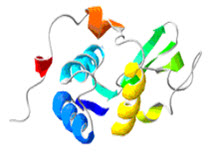

Proteins are organic compounds made of amino acids arranged in a linear chain and folded into a globular form. The amino acids in a protein are joined together by the peptide bonds between the carboxyl and amino groups of adjacent amino acid residues. The sequence of amino acids in a protein is defined by the sequence of a gene, which is encoded in the genetic code. In general, the genetic code specifies 20 standard amino acids that are used to create proteins. Shortly after or even during synthesis, the residues in a protein are often chemically modified by post-translational modification, which alters the physical and chemical properties, folding, stability, activity, and ultimately, the function of the proteins.
Most proteins fold into unique 3-dimensional structures. The shape into which a protein naturally folds is known as its native conformation. Protein structure can be displayed using different representations as shown below for of the protein triose phosphate isomerase. The left figure is an all-atom representation colored by atom type. In the middle is a simplified representation illustrating the backbone conformation, colored by secondary structure? To the right is a solvent-accessible surface representation colored by residue type (acidic residues red, basic residues blue, polar residues green, nonpolar residues white).
The size of a protein is an important physical characteristic that provides useful information including the presence of monomers, dimer and trimer, changes in conformation, aggregation state, and denaturation. Protein scientists typically discuss “protein size” or molecular weight, as opposed to using the phrase “particle size”, but particle size analyzers are often used in their studies. There is also interest in the surface charge or valence of proteins, so zeta potential is another measurement used by protein chemists. The most common particle size analysis technique for protein characterization is dynamic light scattering. Zeta potential can be measured using either electrophoretic light scattering or electro acoustic spectroscopy.
Lysozyme is a common protein that can be challenging at low concentrations. This Application Data Sheet presents particle size results for lysozyme measured at 0.1 mg/mL concentration.

Visualization of lysozyme
Application Data Sheet: Measuring Lysozyme with the SZ-100
Zeta potential is a key physical parameter that describes surface charge on proteins. Although there has been interest in measuring the zeta potential of proteins for many years, the measurements were often difficult due to a variety of reasons including the “cooking” of proteins on the cell electrodes when using older light scattering techniques. The SZ-100V2 nanoparticle analyzer utilizes patented carbon coated electrodes in disposable zeta potential cells that minimizes the problems experienced when measuring the zeta potential of proteins.

The AGILE Carbon Zeta Potential Cell for the SZ-100
Nanoparticle Analyzer
Do you have any questions or requests? Use this form to contact our specialists.